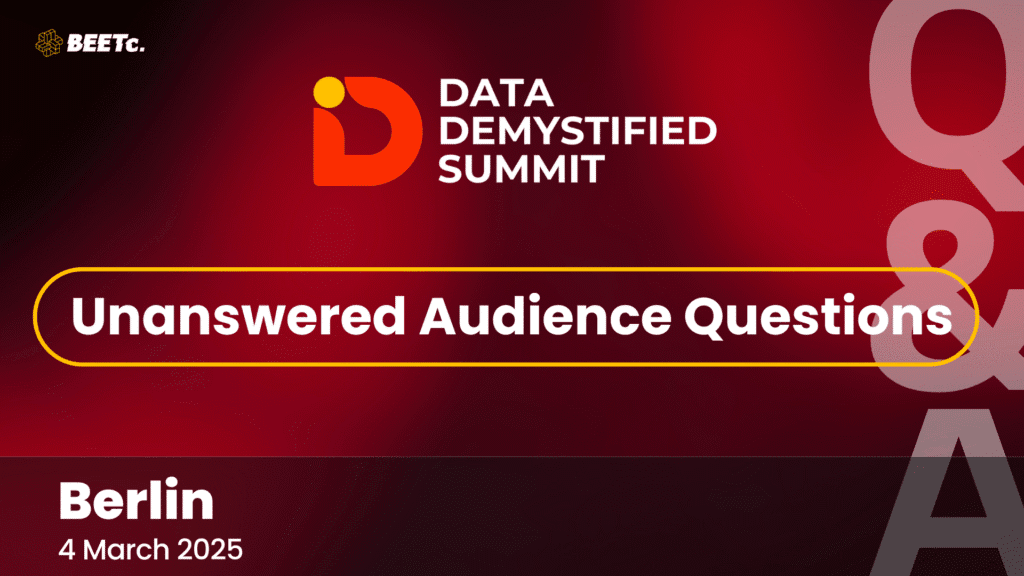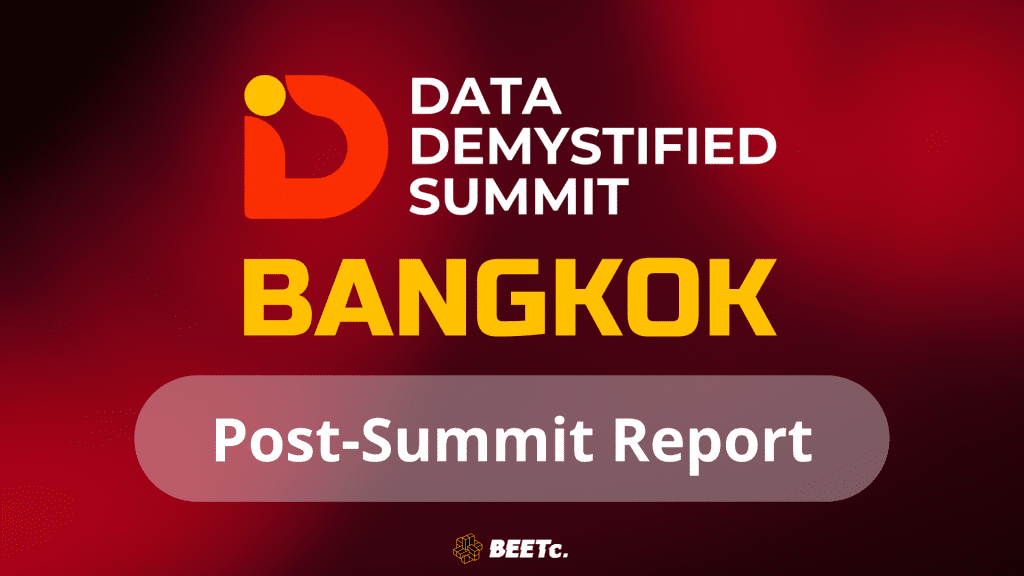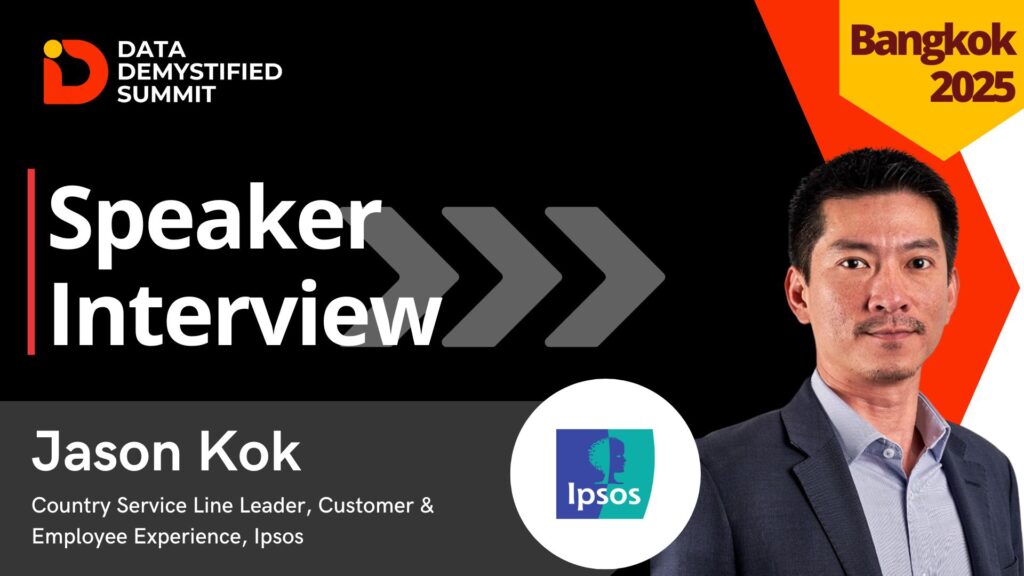The Data Demystified Summit made its Berlin debut on 4 March 2025 at the InterContinental Hotel Berlin, bringing together 150 senior-level data professionals and 25 distinguished speakers from across the EMEA region. This inaugural event in Berlin served as a dynamic platform for high-level networking and in-depth knowledge exchange, focusing on the latest trends and technologies shaping the customer data landscape in 2025.
Now, welcome to our summit’s aftermath – Join us as we unravel the mysteries and shed light on the lingering questions posed to the brilliant speakers who captivated us during the summit!

Experience the summit in motion with BEETc On-Screen – our on-demand learning platform offering exclusive access to past Data Demystified Summit sessions, insightful webinars, and more. Use code PSR1MON to register now and enjoy 1 month of free access. Catch up, revisit, and discover fresh perspectives at your own pace.
Presale Now On, Limited Tickets, Grab It Before It’s Gone!
In 2026,Data Demystified Summit is returning to Berlin! PRESALE is now open! Get 60% off your summit pass and secure your spot.
*Limited time and limited tickets
Unanswered Q&A from Data Demystified Summit Berlin
[Data Governance] Building Customer Data Governance Frameworks for Trust, Compliance and Security
Speaker:
Artur Yatsenko, Director, Data Engineering, Urban Sports Club
❓You mentioned last year’s data leak at USC. How did this affect your data governance processes?
The incident helped us rethink the ways of working and put a lot more effort into security and compliance, even though the incident was not a result of a breach, but a human error. We have invested heavily in increasing our security posture, which resulted in raising our security scorecard from F to A, enhancing policies and guidelines, reviewing retention & deletion policy, and doing foundational work for SOC2/ISO27001 preparation. We implemented tooling for threat and vulnerability detection, conducted pen tests and launched an internal security training program, amongst other actions, as a result of the incident.
[Data Monetisation] Unlocking Revenue Streams through Strategic Customer Data Utilisation
Speaker:
Dolores Jovanovic, Product & Technology Analytics, idealo
❓How do you determine the potential financial impact of data when there aren’t often concrete direct effects, especially at the beginning of the data journey?
Determining Financial Impact of Data in Early Stages
While starting to collect data, start with data valuation methods as well to estimate potential impacts:
- Predictive Analytics: Utilise historical data to predict future trends – if the topic is completely new, define what industry/events could have similar historical paths.
- Benchmarking: Compare your performance metrics with industry standards or similar companies that have successfully implemented data-driven practices.
- Pilot tests: Implement small-scale projects to test hypotheses and gather data, which can help estimate larger-scale impacts before full implementation. Use pilot projects for A/B testing with the rest of the business, if applicable, to compare.
- Value Proposition Creativity: Identify types of value – for example, improved decision-making, enhanced customer experience, process efficiencies, etc, to create a qualitative impact.
❓How to maintain good data quality? Any strategies?
Make sure you prioritise data quality over data quantity because one good conclusion brings something positive, while many wrong conclusions can’t bring you forward. Main quality aspects:
- Data Governance Framework: Establish clear policies, roles, and responsibilities for data management to ensure accountability.
- Data Validation: Regularly clean and validate data to identify and rectify inaccuracies – build automated processes for detecting anomalies and outliers.
- Standardisation: Develop and implement data entry standards and formats to ensure consistency across datasets, reducing variability.
- Regular Audits: Conduct audits and assessments of data quality to evaluate compliance with standards and identify areas for improvement.
- Training and Culture: Foster a data-driven culture by training employees on the importance of data quality and best practices for data management.
❓How do you measure the ROI for the data products you develop? Do you focus more on uplifts or on reducing spend (CPA, etc.)?
Focus on measuring increases in revenue generated directly from insights gained through data products, such as improved sales (quality, revenue, loyalty; not only transactions) from data-driven marketing campaigns.
Evaluate savings gained through efficiencies created by data products, like reduced customer acquisition costs (optimised promotion value) or reduced length and cost of inefficient campaigns – when data showed you inefficiency in the early stage of the campaign.
Implement a framework that compares savings with revenue increase from investing in more ROI effective campaigns, ensuring a comprehensive view of ROI.
You mentioned connecting data & analytics initiatives to company objectives and KPIs. How do you do this? Do you use company KPI trees?
Make sure that what you measure with data has a corresponding measure in the list of company objectives, and it’s easy to connect to the main KPIs. Understand Business Objectives to have a clear picture of what makes sense to optimise.
Use KPI trees to visualise the relationships between different business goals and relevant KPIs; all specific initiatives or metrics should be connected to data projects. Engage all departments to understand their objectives, ensuring that analytics initiatives directly support KPIs across the company, avoiding any silo.
❓Every business stakeholder says they want more data or more value from data. But what do you think stops them from translating into getting more engaged?
Stakeholder Engagement with data depends on various factors as:
- Data Literacy (a lack of understanding of how to interpret and leverage data)
- Siloed Data (stakeholders need to access a comprehensive view to make a decision, not to compare data discrepancies over departments)
- Complicated Tools (lack of the necessary tools or platforms for data analysis and visualisation)
- Presentation Complexity (If data products or dashboards are complex, stakeholders may feel overwhelmed and less likely to engage)
Addressing these issues requires a proactive approach to communication, education, and infrastructure development, ensuring that stakeholders see tangible value in engaging with data initiatives. Think about stakeholders as the final customer, research what the key needs, skills and how data will be used. A checklist for each data product should include who will use it, how, when, and why – and it should be realistically answered and tailor-made.
Throughout the event, your inquiries ignited conversations and fueled our curiosity. Your engagement has truly enhanced the experience for all involved. For those unable to attend the live sessions or wanting to revisit the insightful discussions and presentations, we invite you to access the BEETc On-Screen on our learning platform. Let’s continue to connect, learn, and grow together, fostering innovation and excellence in the ever-evolving landscape of marketing technology. We eagerly anticipate welcoming you back at future events. Of course, there are more exciting in-person events throughout the year, please visit:
Stay tuned for updates!
Last updated: August 2025







